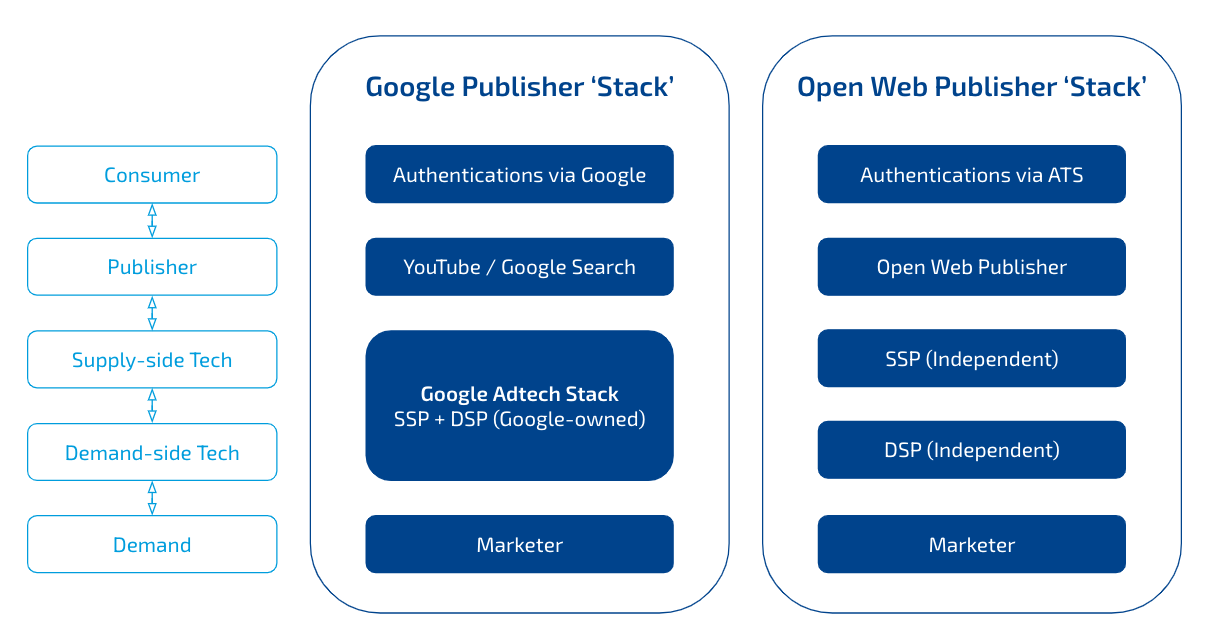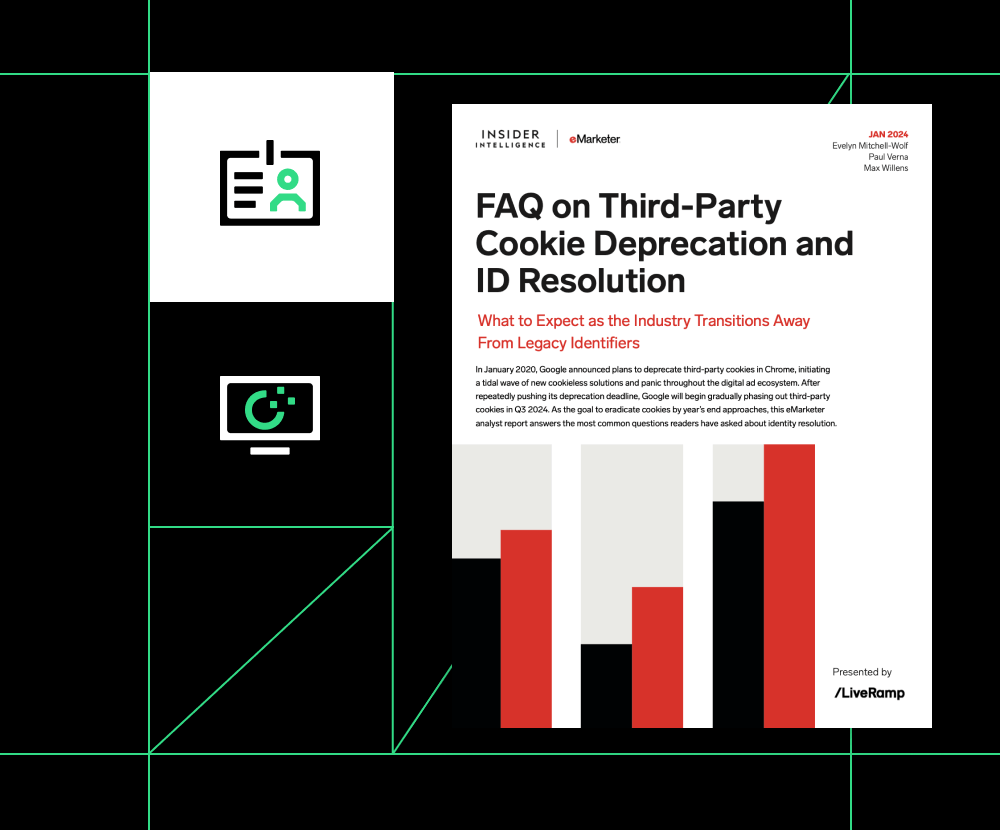Yesterday, Google provided further guidance on their vision for the cookieless future, announcing that they would be focusing their buy-side technology on Federated Learning of Cohorts (FLoC) and not leveraging other identifiers for their programmatic buy-side platform. Google highlighted the importance of first-party data and developing strong, direct consumer relationships – a truth LiveRamp has long championed. Google also acknowledged that ultimately the publisher controls their relationship with the consumer, and they will support other IDs on their sell-side platform.
While this announcement was expected and very much in-line with what we’ve been advocating for years, it undoubtedly created some noise and confusion in the market. We issued our own blog in response to this news yesterday – and we wanted to take the opportunity to address some of the most common questions we’ve received after talking to dozens of industry participants.
1. What exactly was announced? Does this mean that Google will not support any identifiers in Chrome?
Google’s announcement can be distilled into three key points:
- Google will not natively support user-level buying in their DSP, DV360. They are instead going to take a cohort approach – called FLoCS, Federated Learning of Cohorts. We expect marketers will still be able to execute Private Marketplace deals, across one or many publishers, enabled by Authenticated Traffic Solution (ATS) on DV360, as many do today.
- Google will not build their own proprietary ID, and they have indicated they will support publisher first-party data enabled by infrastructure such as ATS via their supply-side platform.
- Building first-party relationships is more important than ever – which is at the very core of what we enable with ATS and Safe Haven.
Importantly, this announcement does not change LiveRamp’s integrations with Google’s owned properties, like Google Search or YouTube – nor does it suggest Google will discontinue the use of identifiers within Chrome. In fact, this announcement reinforces that Chrome will enable publishers to use people-based identifiers in addition to FLoCs.
2. How do you respond to Google’s statement that it does not believe identity solutions will stand the test of time?
ATS embraces the very principles Google outlined in its blog. ATS puts consumer transparency and control above all else. It champions the importance of first-party, consented relationships, enabling a direct connection between a publisher’s authenticated first-party data and marketer demand. ATS mimics the very approach Google has and continues to take with its own properties like Google Search and YouTube. ATS just makes these capabilities available to non-walled garden publishers so that the open web can compete on a level playing field and publishers can continue to provide the free content we all enjoy. ATS does not leverage authentications from one site for another site, nor does it create a co-op of publisher data. ATS is all about putting the publisher in control of their relationship with the consumer. Through login events, publishers can match data through their ad tech stack, just like Google search and YouTube. And by leveraging ATS controls, publishers always remain in control of their data.
Comparing Publisher Models:

3. I’m a marketer who primarily uses DV360 for my audience-based campaigns – what does this mean to me?
We encourage marketers using DV360 as their buy-side platform to start transacting on LiveRamp’s ID via Private Marketplace deals across the SSPs that support ATS. These campaigns can work across all of the publishers on a SSP and can be designed to be very similar to Open Exchange bidding. Today, we are integrated with all major SSPs, including Index Exchange, Magnite, OpenX, PubMatic, and just announced and soon to be live, Xandr. These campaigns perform better today, can increase reach on Safari and Firefox, and ensure that marketers are set up for future success.
In addition, ATS is integrated with over 45 other leading DSPs, including Amobee, MediaMath, and The Trade Desk, that will continue to leverage LiveRamp to support audience-based buying on their platforms. If you are working with multiple DSPs today, we suggest you consider experimenting with shifting some of your audience-based buying from DV360 to another DSP partner.
The LiveRamp team can help guide you through a plan to test solutions and prepare for these upcoming changes.
4. I’m a publisher – is the juice still worth the squeeze for authentications?
The short answer, yes – it’s now more critical than ever. Authentications translate into higher-value inventory and better data. Authenticated approaches enable publishers to connect their inventory to advertisers’ target audiences with precision, boosting both CPMs and consumer trust. This is why Google is using authentication for their Search and YouTube inventory – they are relying on authentication for monetization, and the rest of the ecosystem should follow their lead.
Publishers that are quick to adopt an authentication strategy will gain a significant competitive advantage. While publishers should work towards achieving at least 30% authentication rates, authentication on even 5 to 10% of traffic today is enough to boost the bottom line. For example, recent analysis of publisher yields suggests publishers can generate as much as a 350% improvement in yields on Safari and a 50% improvement in yields on Chrome when leveraging ATS as compared to third-party cookies. Yesterday’s announcement only reinforces the need for publishers to develop authenticated and trusted consumer relationships.
5. What exactly are FLoCS and how should I think about them in relation to my media plan?
Google’s Federated Learning of Cohorts (FLoC) is a post-cookie solution that helps marketers reach audiences by clustering large groups of browsers with similar interests as ranked by Chrome. Think about FLoCs as an improvement from contextual advertising but far inferior to audience-based buying and fully controlled by Google. This method “masks” the user by placing them within a group of browsers and is done via Google’s processing. Since their web history can’t be exposed to third parties, this method is private and secure. Keep in mind that cohorts aren’t individuals or people-based, so the larger the cohort, the greater the chance of diversity within the group, making it a challenge for marketers to personalize, measure, and attribute their campaigns. For marketers who want to maximize reach and return and for publishers who want to maximize yields, people-based audience-based buying and selling should remain at the very top of the tactic list and be supplemented with cohort-based or contextual advertising for unauthenticated inventory.
6. How do email-only solutions stack up to ATS?
Email-only solutions have their limitations given the sheer number of email addresses individuals maintain. For example, I log into certain sites as [email protected], others as [email protected], others using my former college email address, [email protected], and other sites I still log in using not my email address, but my phone number. ATS, leveraging LiveRamp’s AbiliTec offline resolution technology, can help resolve these various email addresses and phone numbers to the same person – me. This way, Dollar Shave Club, or name your brand, can deliver me a consistent and cohesive experience across all of the sites I visit. It also makes measurement on the back-end so much more effective and efficient. A marketer may often have an email for targeting purposes but only a name and postal address for an in-store purchase record. LiveRamp can bring this all together in a secure and encrypted way. Further, LiveRamp’s identifier and ATS are omnichannel and work across display, mobile in-app, connected TV and OTT, making them durable and valuable to marketers who need to activate, measure, and attribute across multiple channels. Finally, and even most importantly, email-only solutions are often not as secure as ATS. ATS provides each platform a unique encrypted identifier for every user – if one platform is compromised, the IDs they have are only relevant to their platform, not to anyone else.
Google’s announcement yesterday clearly indicates that the end of the third-party cookie is imminent and will happen in early 2022 – now is the time for marketers and publishers to take action. Google is using people-based identity for its most valuable inventory, Search and YouTube. And to remain competitive, other publishers should do the same and maximize their authentications. Marketers should prioritize buying people-based inventory wherever they can. Now is the time for collective action.
Read more about our take on this week’s news via these recent blogs:
- Google Clarifies Its Plans for Targeted Advertising—And What That Means For You
- Has Google’s Announcement Left You Wondering What You Need to Do Next?
Reach out to [email protected] to find out how you can deploy ATS or launch a people-based marketing campaign today.



